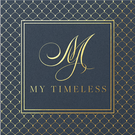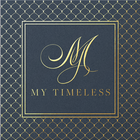Art Deco Era (1920-1935)
The First World war profoundly changed the role of women in society. When the war ended, many women, proud of their emancipation, stayed on in their jobs, and favored the new tendency of fashion towards a masculine look, characterized by a thin and flat silhouette, and a short haircut, '‘a la garçonne '. Trousers understandably became an emblem of the emancipated woman for day wear
Coco Chanel, in the late 1920s, launched her sporty, yet elegant and classy fashions, which were to remain in vogue for some time. Her classical two-piece suits became the indispensable garment for all fashionable women.
In order to follow these revolutionary innovations in fashion, jewellery changed accordingly. Jewellery assumed more geometrical and linear designs; the garland style, which employed delicate feminine motifs with a predominance of white, black and pale pastel colors, was replaced by dazzling outbursts of vivid, primary colors. Jewels became an accessory, strictly dependent on the shape and color of the dress on which they were worn, rather than a precious ornament to represent a display of wealth as had been the case in the pre-war years. Many fashionable women, obsessed with perfection, had clothes designed to suit a particularly important piece of jewellery.
The scantily clothed woman of the 1920s loved to cover herself with jewellery: several bracelets were worn at the same time on arms left bare by evening

dresses. The daringly low backs of dresses promoted the fashion for sautoirs and necklaces worn at the back rather than at the front.

sautoirs and necklaces worn at the front, Queen Alexandra, Queen Consort of king Edward-vii
Cartier, Boucheron, and Van Cleef & Arpels were strongly influenced by the fascination of Egypt and quickly adapted their production. The primary colours of Jaipur enamel jewellery inspired many of the ruby, emerald and diamond creations of the late 1920s. Indian beads were also frequently mounted in clusters on bracelets, brooches and clips

Cartier Brooch Egyptian revival jewelry, Jewels, Art deco jewelry Sotheby’s auction
Carved rubies, sapphires and emeralds, typical of Indian jewellery, also found their way to Europe, and in the shape of flowerheads, leaves, fruits and berries (Tutti Frutti Style), were frequently mounted in jewels of Oriental inspiration and in the 'giardinetto' brooches of western tradition

Art Deco Diamond and Carved Colored Stone Tutti Frutti Brooch
Also favoured large metallic surfaces, often decorated with lacquers and enamels, and carved hardstones such as jade, coral, onyx, rock crystal and lapis lazuli. Among the faceted stones, their main choices were aquamarine, citrine, topaz and amethyst. Diamonds were employed to pick out a decorative motif, and coloured precious stones seldom appeared in their creations.

Christie’s Auction Art Deco Georges Fouquet pendant

The best known artist-jewellers of the time were George (1862-1957) and Jean (1899- 1994) Fouquet, Gerard Sandoz (1902-1995), Raymond Templier (1891-1968), Jean Despres(1889-1980),and Jean Dunand (1877-1942).

